Analysis of Human Resource Management in Tesco PLC
VerifiedAdded on 2021/05/31
|12
|2858
|21
Report
AI Summary
This report provides a comprehensive analysis of the human resource management (HRM) functions within Tesco, a prominent retail organization in the United Kingdom. It begins with an executive summary and table of contents, followed by an overview of Tesco, its market position, and the scope of the analysis. The report then delves into the purpose, roles, and responsibilities of HRM within Tesco, emphasizing its significance in maximizing productivity and meeting business needs. A detailed examination of workforce planning is presented, covering Tesco's approach to aligning workforce with organizational goals, addressing future needs, and conducting HR gap analysis. The report assesses Tesco's processes for planning, recruitment, selection, and training. Furthermore, it outlines the recruitment and selection model and explores the approaches to training and development employed by the company. The report concludes with a summary of key findings and insights into Tesco's HRM practices, supported by relevant references.
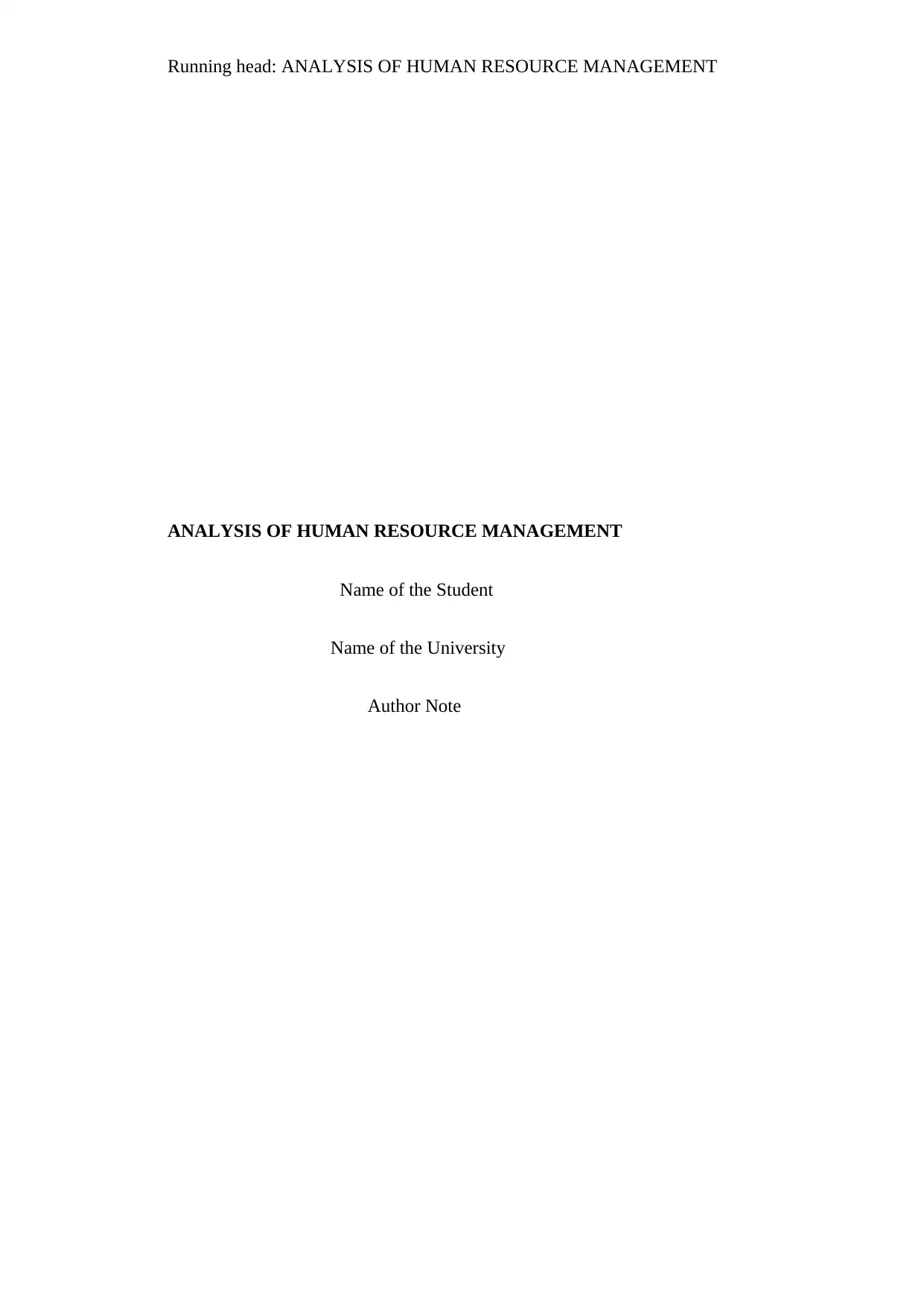
Running head: ANALYSIS OF HUMAN RESOURCE MANAGEMENT
ANALYSIS OF HUMAN RESOURCE MANAGEMENT
Name of the Student
Name of the University
Author Note
ANALYSIS OF HUMAN RESOURCE MANAGEMENT
Name of the Student
Name of the University
Author Note
Paraphrase This Document
Need a fresh take? Get an instant paraphrase of this document with our AI Paraphraser
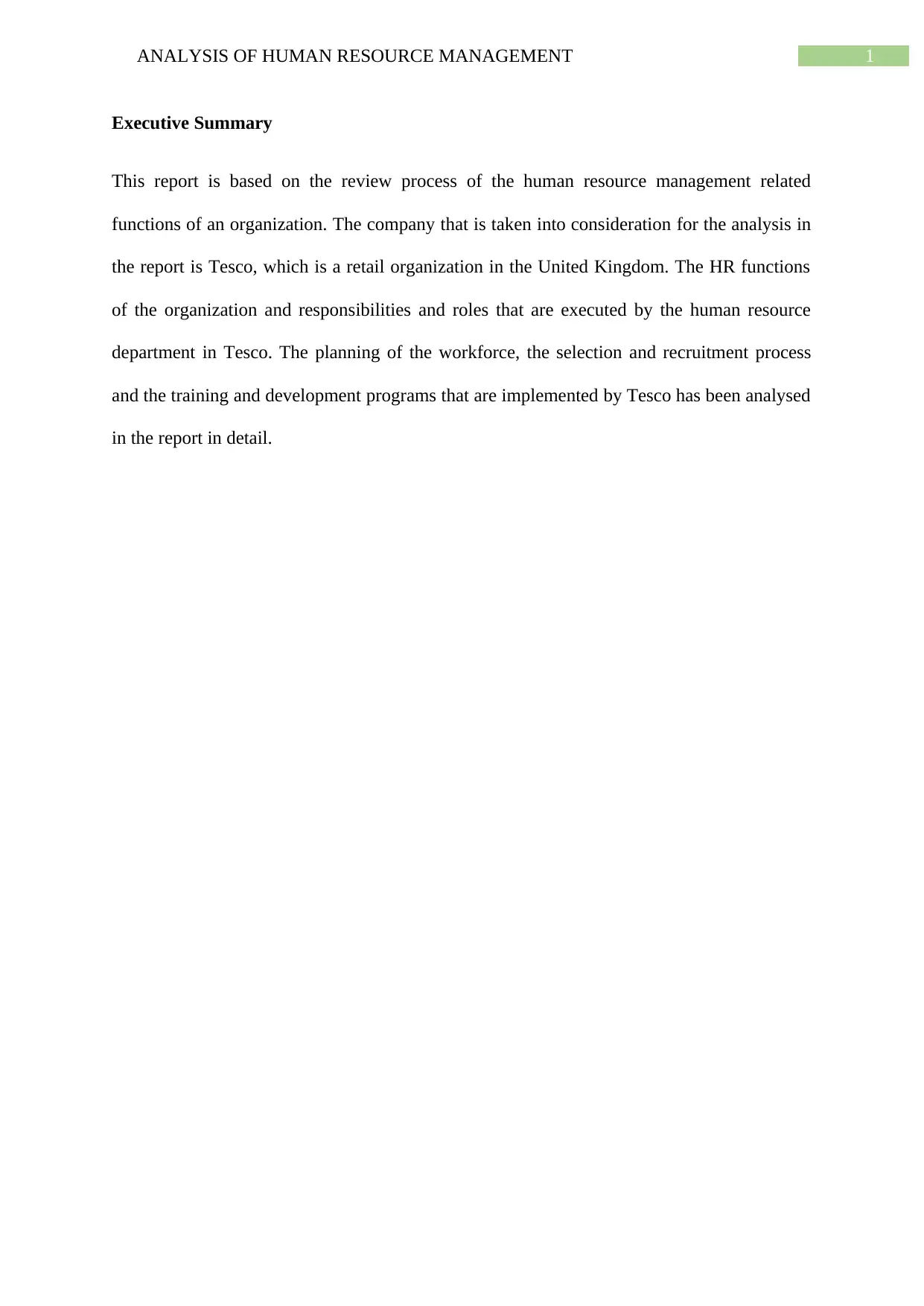
1ANALYSIS OF HUMAN RESOURCE MANAGEMENT
Executive Summary
This report is based on the review process of the human resource management related
functions of an organization. The company that is taken into consideration for the analysis in
the report is Tesco, which is a retail organization in the United Kingdom. The HR functions
of the organization and responsibilities and roles that are executed by the human resource
department in Tesco. The planning of the workforce, the selection and recruitment process
and the training and development programs that are implemented by Tesco has been analysed
in the report in detail.
Executive Summary
This report is based on the review process of the human resource management related
functions of an organization. The company that is taken into consideration for the analysis in
the report is Tesco, which is a retail organization in the United Kingdom. The HR functions
of the organization and responsibilities and roles that are executed by the human resource
department in Tesco. The planning of the workforce, the selection and recruitment process
and the training and development programs that are implemented by Tesco has been analysed
in the report in detail.
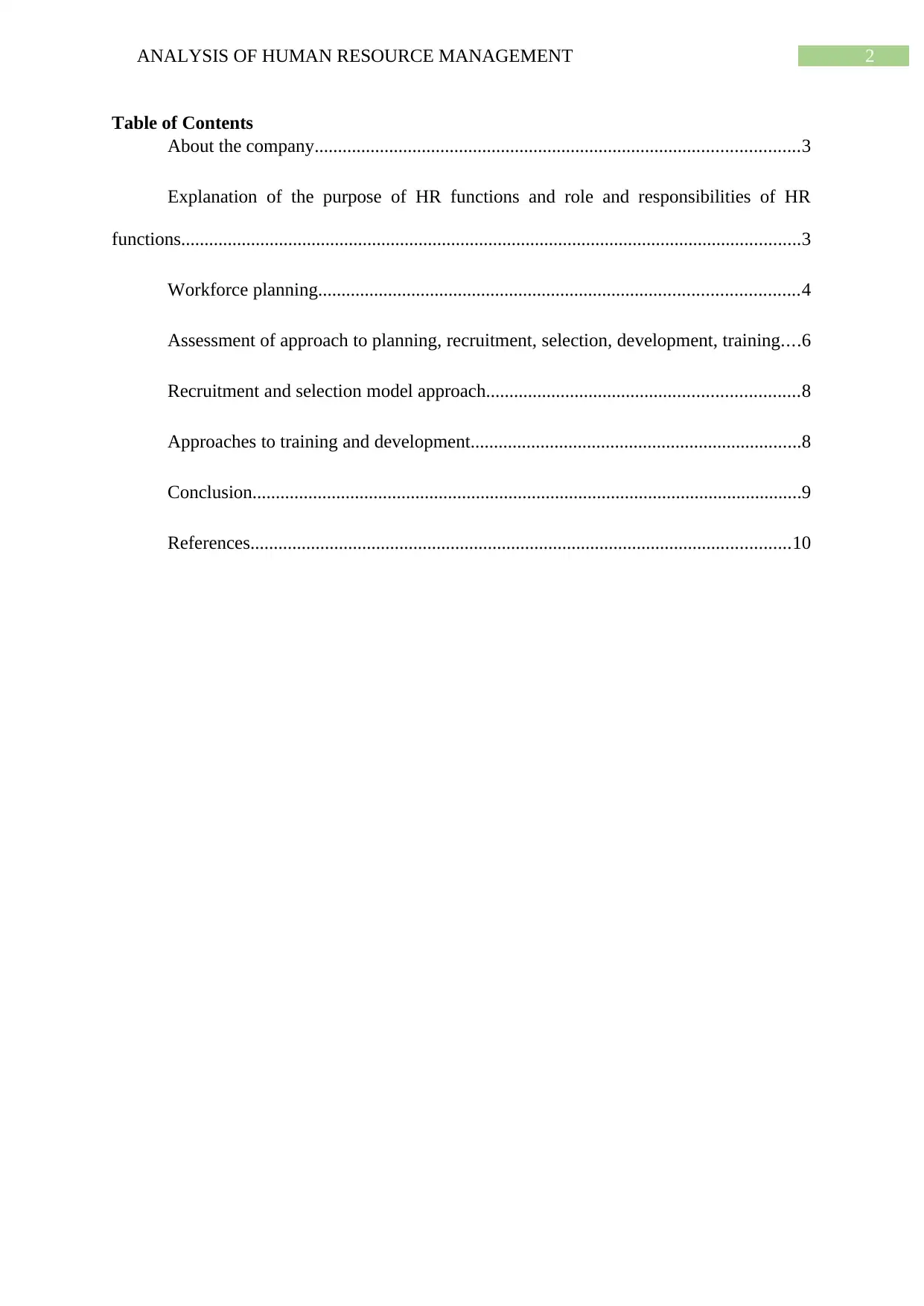
2ANALYSIS OF HUMAN RESOURCE MANAGEMENT
Table of Contents
About the company........................................................................................................3
Explanation of the purpose of HR functions and role and responsibilities of HR
functions.....................................................................................................................................3
Workforce planning.......................................................................................................4
Assessment of approach to planning, recruitment, selection, development, training....6
Recruitment and selection model approach...................................................................8
Approaches to training and development.......................................................................8
Conclusion......................................................................................................................9
References....................................................................................................................10
Table of Contents
About the company........................................................................................................3
Explanation of the purpose of HR functions and role and responsibilities of HR
functions.....................................................................................................................................3
Workforce planning.......................................................................................................4
Assessment of approach to planning, recruitment, selection, development, training....6
Recruitment and selection model approach...................................................................8
Approaches to training and development.......................................................................8
Conclusion......................................................................................................................9
References....................................................................................................................10
⊘ This is a preview!⊘
Do you want full access?
Subscribe today to unlock all pages.

Trusted by 1+ million students worldwide
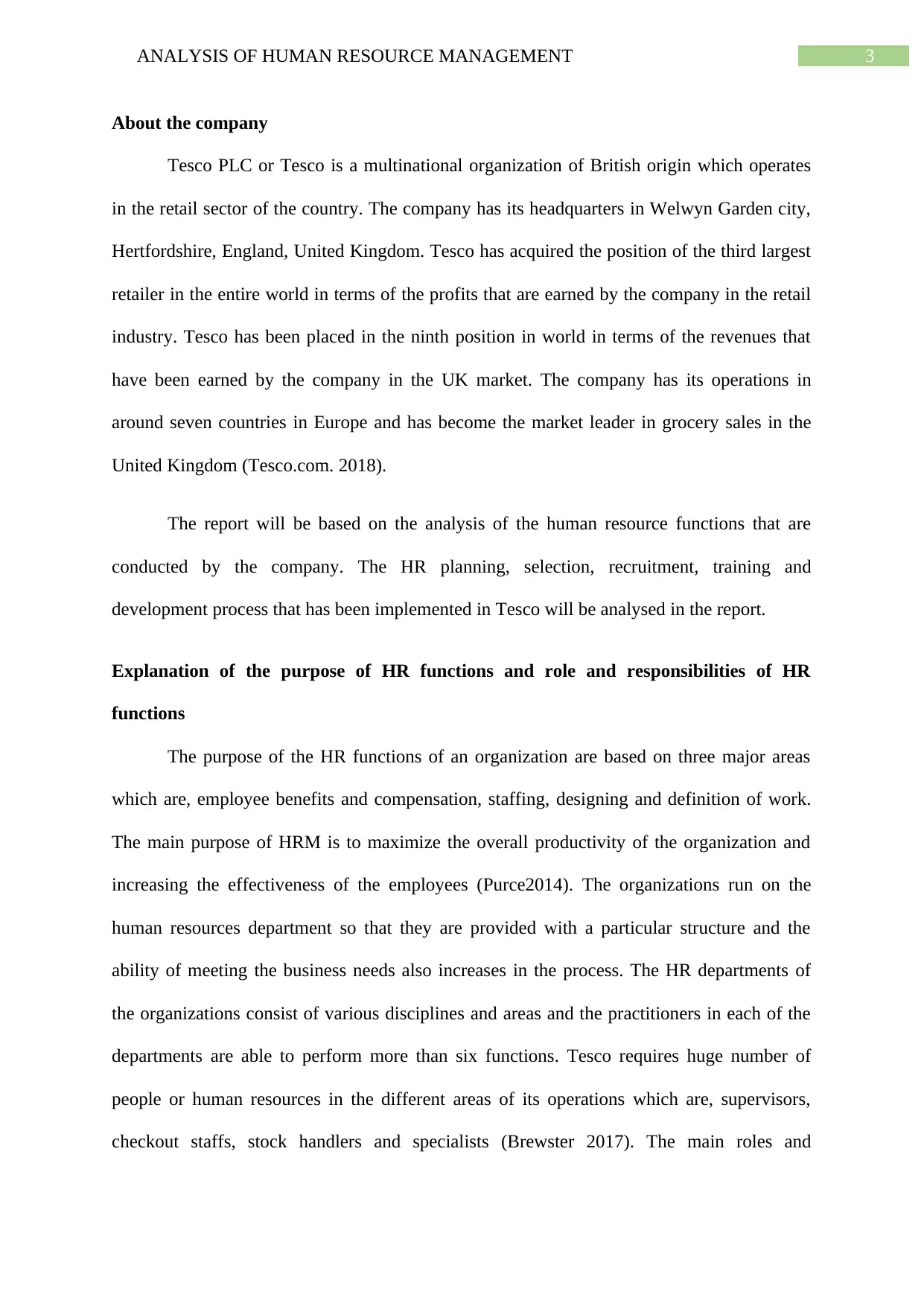
3ANALYSIS OF HUMAN RESOURCE MANAGEMENT
About the company
Tesco PLC or Tesco is a multinational organization of British origin which operates
in the retail sector of the country. The company has its headquarters in Welwyn Garden city,
Hertfordshire, England, United Kingdom. Tesco has acquired the position of the third largest
retailer in the entire world in terms of the profits that are earned by the company in the retail
industry. Tesco has been placed in the ninth position in world in terms of the revenues that
have been earned by the company in the UK market. The company has its operations in
around seven countries in Europe and has become the market leader in grocery sales in the
United Kingdom (Tesco.com. 2018).
The report will be based on the analysis of the human resource functions that are
conducted by the company. The HR planning, selection, recruitment, training and
development process that has been implemented in Tesco will be analysed in the report.
Explanation of the purpose of HR functions and role and responsibilities of HR
functions
The purpose of the HR functions of an organization are based on three major areas
which are, employee benefits and compensation, staffing, designing and definition of work.
The main purpose of HRM is to maximize the overall productivity of the organization and
increasing the effectiveness of the employees (Purce2014). The organizations run on the
human resources department so that they are provided with a particular structure and the
ability of meeting the business needs also increases in the process. The HR departments of
the organizations consist of various disciplines and areas and the practitioners in each of the
departments are able to perform more than six functions. Tesco requires huge number of
people or human resources in the different areas of its operations which are, supervisors,
checkout staffs, stock handlers and specialists (Brewster 2017). The main roles and
About the company
Tesco PLC or Tesco is a multinational organization of British origin which operates
in the retail sector of the country. The company has its headquarters in Welwyn Garden city,
Hertfordshire, England, United Kingdom. Tesco has acquired the position of the third largest
retailer in the entire world in terms of the profits that are earned by the company in the retail
industry. Tesco has been placed in the ninth position in world in terms of the revenues that
have been earned by the company in the UK market. The company has its operations in
around seven countries in Europe and has become the market leader in grocery sales in the
United Kingdom (Tesco.com. 2018).
The report will be based on the analysis of the human resource functions that are
conducted by the company. The HR planning, selection, recruitment, training and
development process that has been implemented in Tesco will be analysed in the report.
Explanation of the purpose of HR functions and role and responsibilities of HR
functions
The purpose of the HR functions of an organization are based on three major areas
which are, employee benefits and compensation, staffing, designing and definition of work.
The main purpose of HRM is to maximize the overall productivity of the organization and
increasing the effectiveness of the employees (Purce2014). The organizations run on the
human resources department so that they are provided with a particular structure and the
ability of meeting the business needs also increases in the process. The HR departments of
the organizations consist of various disciplines and areas and the practitioners in each of the
departments are able to perform more than six functions. Tesco requires huge number of
people or human resources in the different areas of its operations which are, supervisors,
checkout staffs, stock handlers and specialists (Brewster 2017). The main roles and
Paraphrase This Document
Need a fresh take? Get an instant paraphrase of this document with our AI Paraphraser
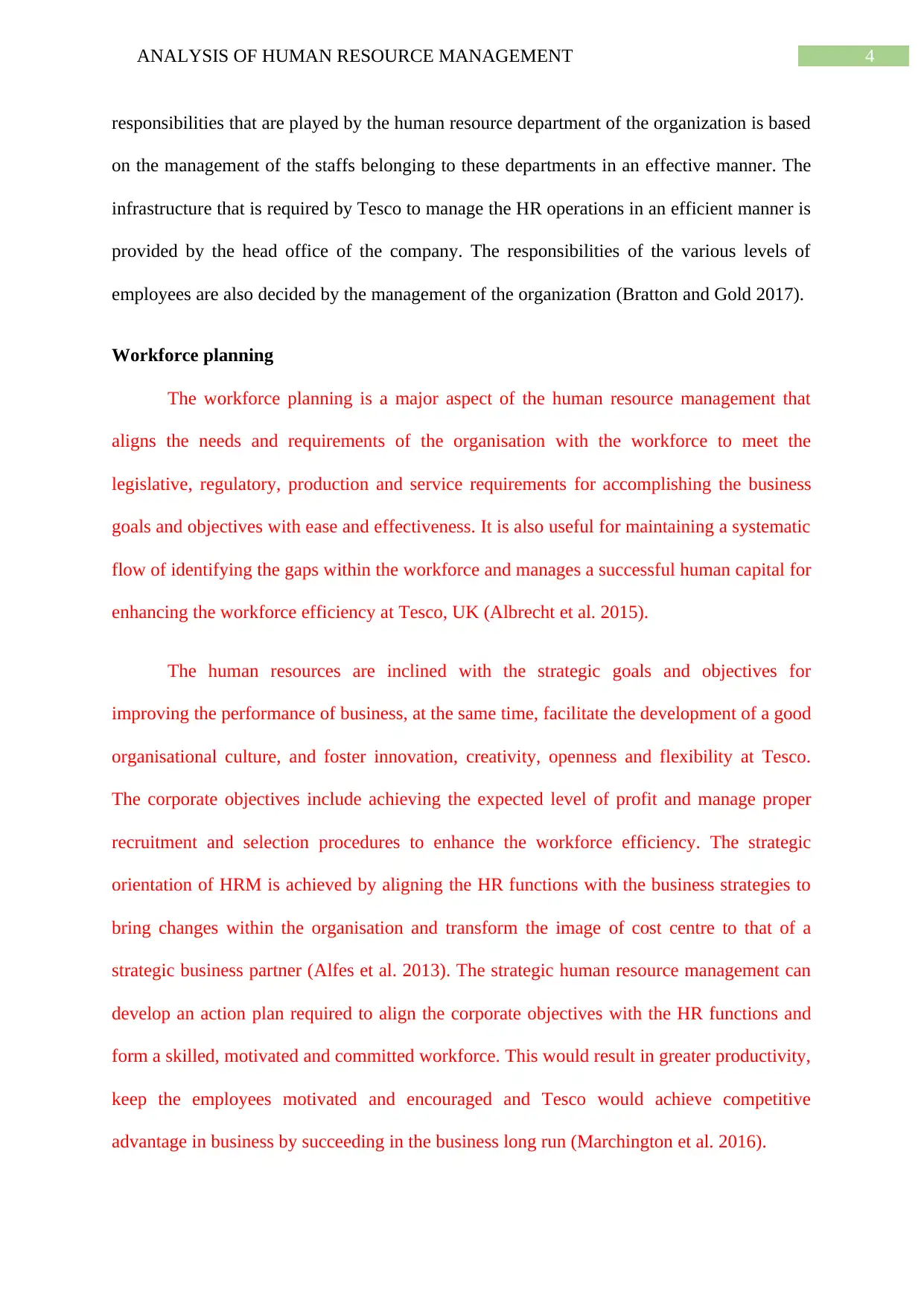
4ANALYSIS OF HUMAN RESOURCE MANAGEMENT
responsibilities that are played by the human resource department of the organization is based
on the management of the staffs belonging to these departments in an effective manner. The
infrastructure that is required by Tesco to manage the HR operations in an efficient manner is
provided by the head office of the company. The responsibilities of the various levels of
employees are also decided by the management of the organization (Bratton and Gold 2017).
Workforce planning
The workforce planning is a major aspect of the human resource management that
aligns the needs and requirements of the organisation with the workforce to meet the
legislative, regulatory, production and service requirements for accomplishing the business
goals and objectives with ease and effectiveness. It is also useful for maintaining a systematic
flow of identifying the gaps within the workforce and manages a successful human capital for
enhancing the workforce efficiency at Tesco, UK (Albrecht et al. 2015).
The human resources are inclined with the strategic goals and objectives for
improving the performance of business, at the same time, facilitate the development of a good
organisational culture, and foster innovation, creativity, openness and flexibility at Tesco.
The corporate objectives include achieving the expected level of profit and manage proper
recruitment and selection procedures to enhance the workforce efficiency. The strategic
orientation of HRM is achieved by aligning the HR functions with the business strategies to
bring changes within the organisation and transform the image of cost centre to that of a
strategic business partner (Alfes et al. 2013). The strategic human resource management can
develop an action plan required to align the corporate objectives with the HR functions and
form a skilled, motivated and committed workforce. This would result in greater productivity,
keep the employees motivated and encouraged and Tesco would achieve competitive
advantage in business by succeeding in the business long run (Marchington et al. 2016).
responsibilities that are played by the human resource department of the organization is based
on the management of the staffs belonging to these departments in an effective manner. The
infrastructure that is required by Tesco to manage the HR operations in an efficient manner is
provided by the head office of the company. The responsibilities of the various levels of
employees are also decided by the management of the organization (Bratton and Gold 2017).
Workforce planning
The workforce planning is a major aspect of the human resource management that
aligns the needs and requirements of the organisation with the workforce to meet the
legislative, regulatory, production and service requirements for accomplishing the business
goals and objectives with ease and effectiveness. It is also useful for maintaining a systematic
flow of identifying the gaps within the workforce and manages a successful human capital for
enhancing the workforce efficiency at Tesco, UK (Albrecht et al. 2015).
The human resources are inclined with the strategic goals and objectives for
improving the performance of business, at the same time, facilitate the development of a good
organisational culture, and foster innovation, creativity, openness and flexibility at Tesco.
The corporate objectives include achieving the expected level of profit and manage proper
recruitment and selection procedures to enhance the workforce efficiency. The strategic
orientation of HRM is achieved by aligning the HR functions with the business strategies to
bring changes within the organisation and transform the image of cost centre to that of a
strategic business partner (Alfes et al. 2013). The strategic human resource management can
develop an action plan required to align the corporate objectives with the HR functions and
form a skilled, motivated and committed workforce. This would result in greater productivity,
keep the employees motivated and encouraged and Tesco would achieve competitive
advantage in business by succeeding in the business long run (Marchington et al. 2016).
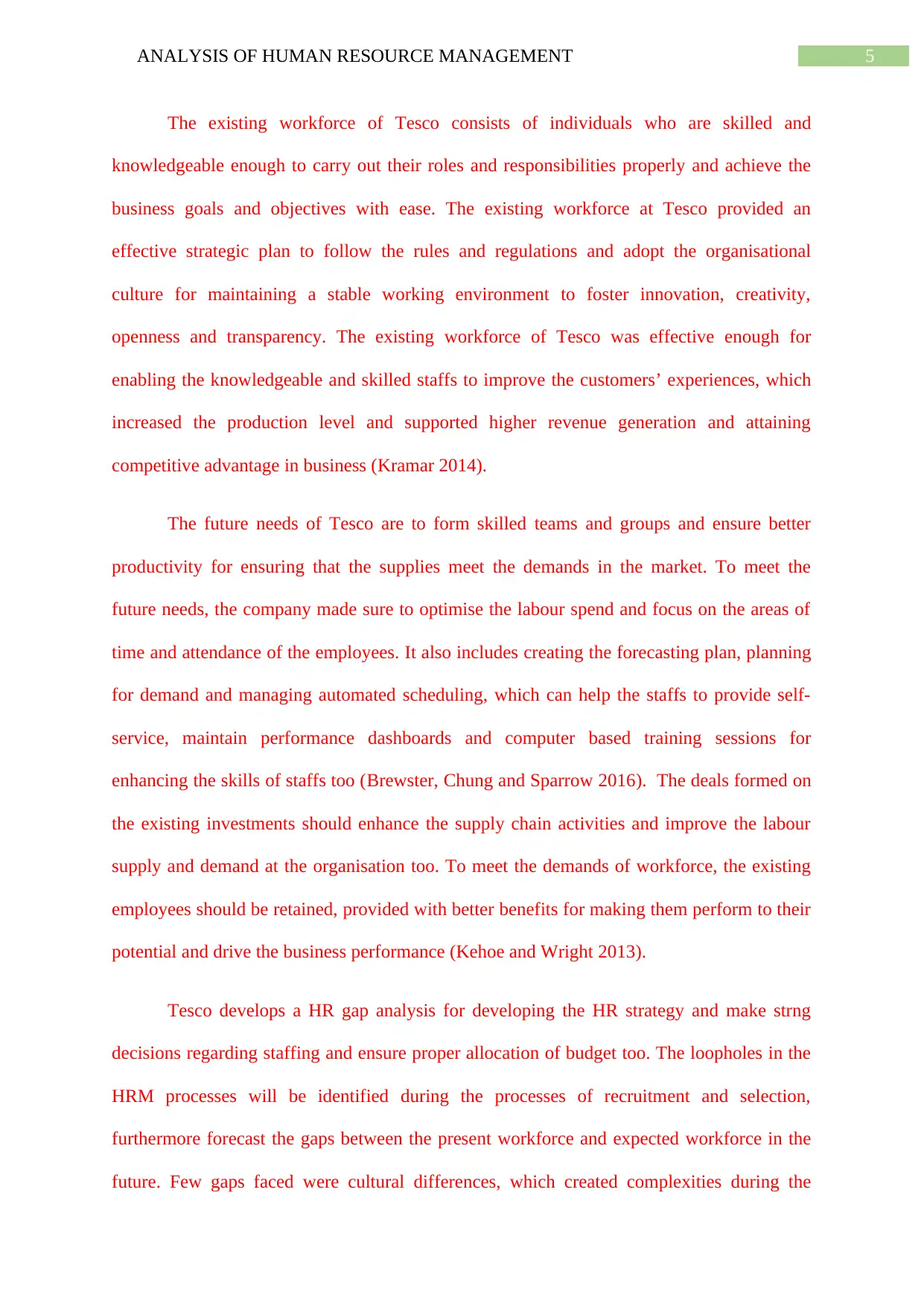
5ANALYSIS OF HUMAN RESOURCE MANAGEMENT
The existing workforce of Tesco consists of individuals who are skilled and
knowledgeable enough to carry out their roles and responsibilities properly and achieve the
business goals and objectives with ease. The existing workforce at Tesco provided an
effective strategic plan to follow the rules and regulations and adopt the organisational
culture for maintaining a stable working environment to foster innovation, creativity,
openness and transparency. The existing workforce of Tesco was effective enough for
enabling the knowledgeable and skilled staffs to improve the customers’ experiences, which
increased the production level and supported higher revenue generation and attaining
competitive advantage in business (Kramar 2014).
The future needs of Tesco are to form skilled teams and groups and ensure better
productivity for ensuring that the supplies meet the demands in the market. To meet the
future needs, the company made sure to optimise the labour spend and focus on the areas of
time and attendance of the employees. It also includes creating the forecasting plan, planning
for demand and managing automated scheduling, which can help the staffs to provide self-
service, maintain performance dashboards and computer based training sessions for
enhancing the skills of staffs too (Brewster, Chung and Sparrow 2016). The deals formed on
the existing investments should enhance the supply chain activities and improve the labour
supply and demand at the organisation too. To meet the demands of workforce, the existing
employees should be retained, provided with better benefits for making them perform to their
potential and drive the business performance (Kehoe and Wright 2013).
Tesco develops a HR gap analysis for developing the HR strategy and make strng
decisions regarding staffing and ensure proper allocation of budget too. The loopholes in the
HRM processes will be identified during the processes of recruitment and selection,
furthermore forecast the gaps between the present workforce and expected workforce in the
future. Few gaps faced were cultural differences, which created complexities during the
The existing workforce of Tesco consists of individuals who are skilled and
knowledgeable enough to carry out their roles and responsibilities properly and achieve the
business goals and objectives with ease. The existing workforce at Tesco provided an
effective strategic plan to follow the rules and regulations and adopt the organisational
culture for maintaining a stable working environment to foster innovation, creativity,
openness and transparency. The existing workforce of Tesco was effective enough for
enabling the knowledgeable and skilled staffs to improve the customers’ experiences, which
increased the production level and supported higher revenue generation and attaining
competitive advantage in business (Kramar 2014).
The future needs of Tesco are to form skilled teams and groups and ensure better
productivity for ensuring that the supplies meet the demands in the market. To meet the
future needs, the company made sure to optimise the labour spend and focus on the areas of
time and attendance of the employees. It also includes creating the forecasting plan, planning
for demand and managing automated scheduling, which can help the staffs to provide self-
service, maintain performance dashboards and computer based training sessions for
enhancing the skills of staffs too (Brewster, Chung and Sparrow 2016). The deals formed on
the existing investments should enhance the supply chain activities and improve the labour
supply and demand at the organisation too. To meet the demands of workforce, the existing
employees should be retained, provided with better benefits for making them perform to their
potential and drive the business performance (Kehoe and Wright 2013).
Tesco develops a HR gap analysis for developing the HR strategy and make strng
decisions regarding staffing and ensure proper allocation of budget too. The loopholes in the
HRM processes will be identified during the processes of recruitment and selection,
furthermore forecast the gaps between the present workforce and expected workforce in the
future. Few gaps faced were cultural differences, which created complexities during the
⊘ This is a preview!⊘
Do you want full access?
Subscribe today to unlock all pages.

Trusted by 1+ million students worldwide
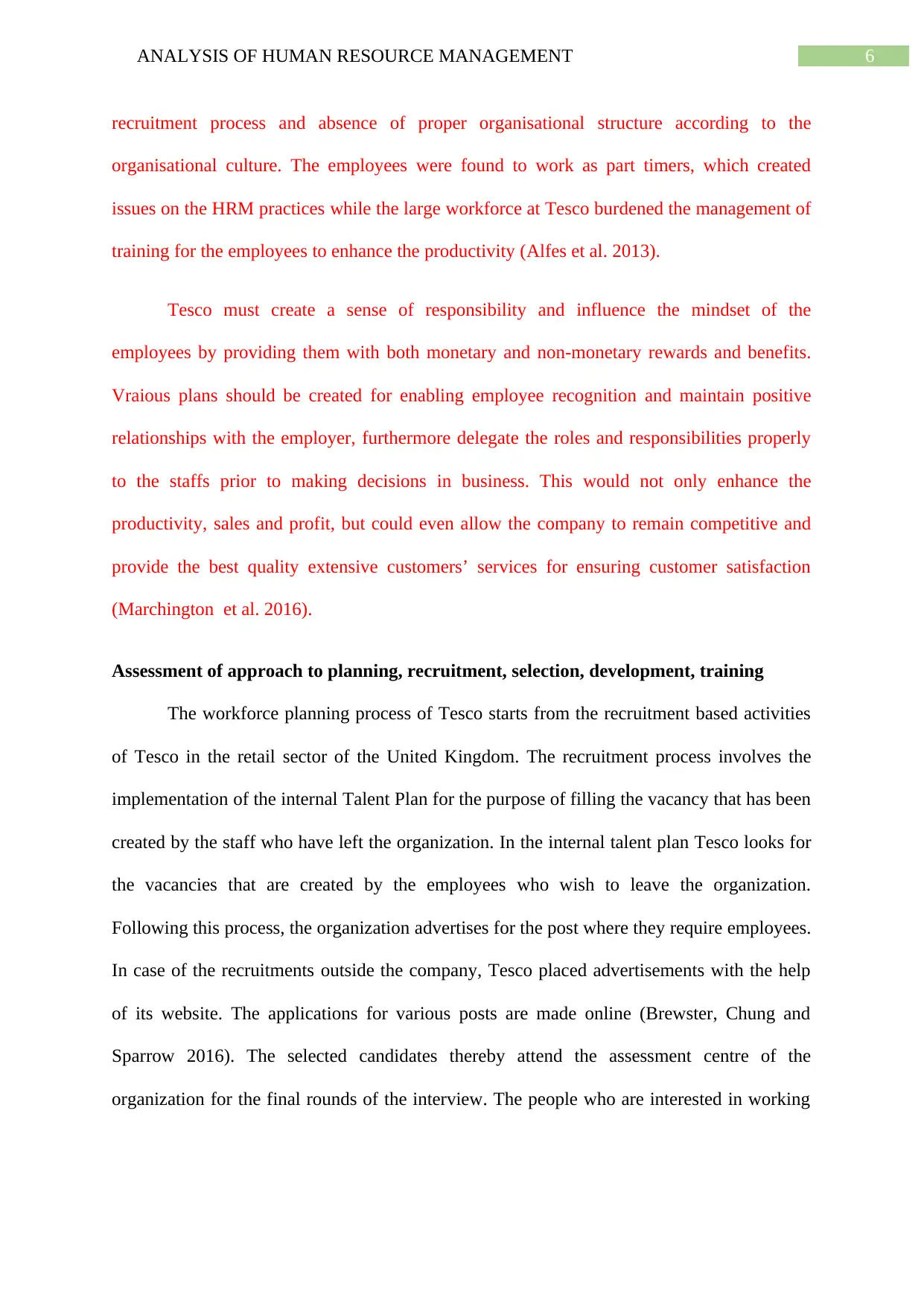
6ANALYSIS OF HUMAN RESOURCE MANAGEMENT
recruitment process and absence of proper organisational structure according to the
organisational culture. The employees were found to work as part timers, which created
issues on the HRM practices while the large workforce at Tesco burdened the management of
training for the employees to enhance the productivity (Alfes et al. 2013).
Tesco must create a sense of responsibility and influence the mindset of the
employees by providing them with both monetary and non-monetary rewards and benefits.
Vraious plans should be created for enabling employee recognition and maintain positive
relationships with the employer, furthermore delegate the roles and responsibilities properly
to the staffs prior to making decisions in business. This would not only enhance the
productivity, sales and profit, but could even allow the company to remain competitive and
provide the best quality extensive customers’ services for ensuring customer satisfaction
(Marchington et al. 2016).
Assessment of approach to planning, recruitment, selection, development, training
The workforce planning process of Tesco starts from the recruitment based activities
of Tesco in the retail sector of the United Kingdom. The recruitment process involves the
implementation of the internal Talent Plan for the purpose of filling the vacancy that has been
created by the staff who have left the organization. In the internal talent plan Tesco looks for
the vacancies that are created by the employees who wish to leave the organization.
Following this process, the organization advertises for the post where they require employees.
In case of the recruitments outside the company, Tesco placed advertisements with the help
of its website. The applications for various posts are made online (Brewster, Chung and
Sparrow 2016). The selected candidates thereby attend the assessment centre of the
organization for the final rounds of the interview. The people who are interested in working
recruitment process and absence of proper organisational structure according to the
organisational culture. The employees were found to work as part timers, which created
issues on the HRM practices while the large workforce at Tesco burdened the management of
training for the employees to enhance the productivity (Alfes et al. 2013).
Tesco must create a sense of responsibility and influence the mindset of the
employees by providing them with both monetary and non-monetary rewards and benefits.
Vraious plans should be created for enabling employee recognition and maintain positive
relationships with the employer, furthermore delegate the roles and responsibilities properly
to the staffs prior to making decisions in business. This would not only enhance the
productivity, sales and profit, but could even allow the company to remain competitive and
provide the best quality extensive customers’ services for ensuring customer satisfaction
(Marchington et al. 2016).
Assessment of approach to planning, recruitment, selection, development, training
The workforce planning process of Tesco starts from the recruitment based activities
of Tesco in the retail sector of the United Kingdom. The recruitment process involves the
implementation of the internal Talent Plan for the purpose of filling the vacancy that has been
created by the staff who have left the organization. In the internal talent plan Tesco looks for
the vacancies that are created by the employees who wish to leave the organization.
Following this process, the organization advertises for the post where they require employees.
In case of the recruitments outside the company, Tesco placed advertisements with the help
of its website. The applications for various posts are made online (Brewster, Chung and
Sparrow 2016). The selected candidates thereby attend the assessment centre of the
organization for the final rounds of the interview. The people who are interested in working
Paraphrase This Document
Need a fresh take? Get an instant paraphrase of this document with our AI Paraphraser
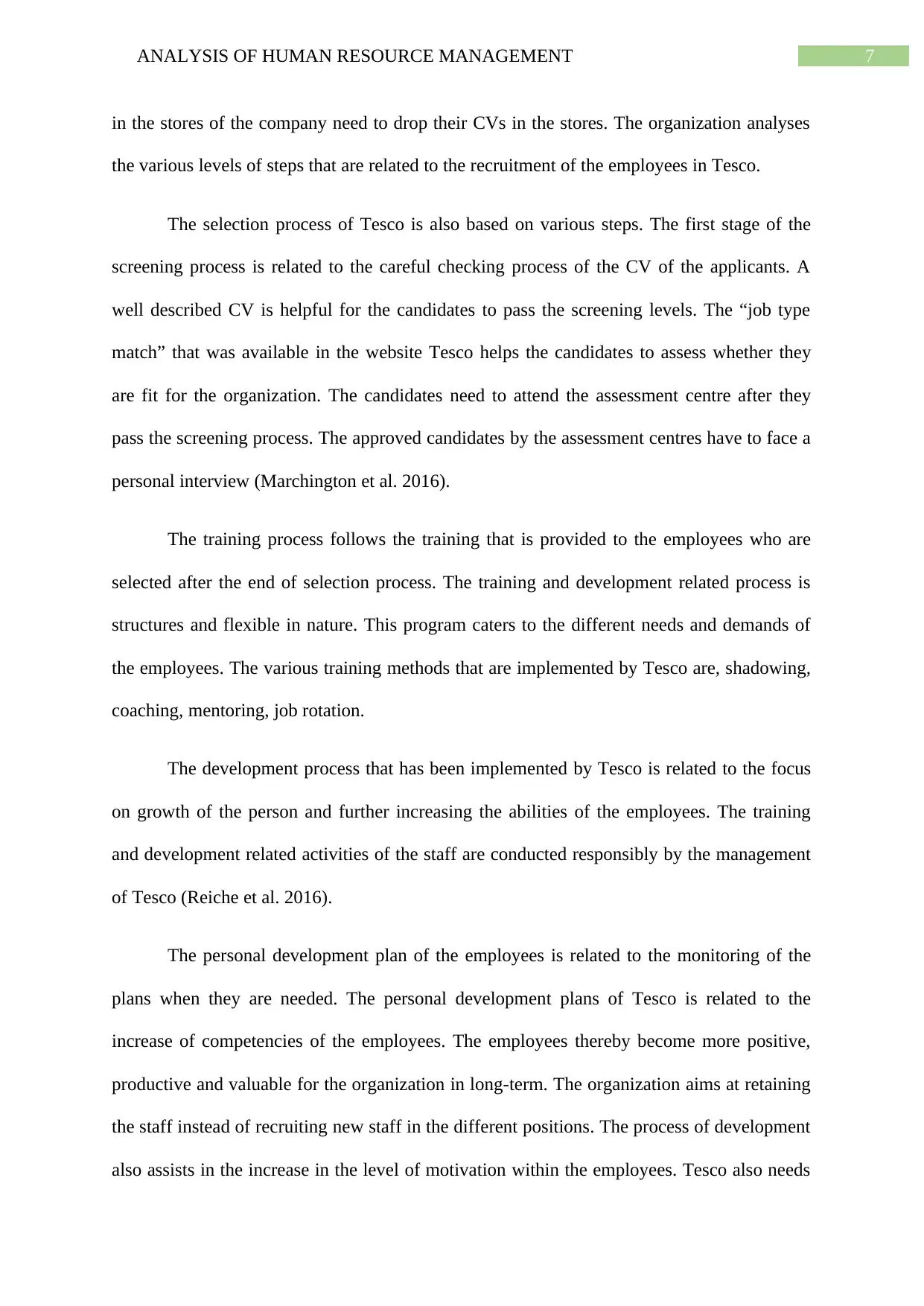
7ANALYSIS OF HUMAN RESOURCE MANAGEMENT
in the stores of the company need to drop their CVs in the stores. The organization analyses
the various levels of steps that are related to the recruitment of the employees in Tesco.
The selection process of Tesco is also based on various steps. The first stage of the
screening process is related to the careful checking process of the CV of the applicants. A
well described CV is helpful for the candidates to pass the screening levels. The “job type
match” that was available in the website Tesco helps the candidates to assess whether they
are fit for the organization. The candidates need to attend the assessment centre after they
pass the screening process. The approved candidates by the assessment centres have to face a
personal interview (Marchington et al. 2016).
The training process follows the training that is provided to the employees who are
selected after the end of selection process. The training and development related process is
structures and flexible in nature. This program caters to the different needs and demands of
the employees. The various training methods that are implemented by Tesco are, shadowing,
coaching, mentoring, job rotation.
The development process that has been implemented by Tesco is related to the focus
on growth of the person and further increasing the abilities of the employees. The training
and development related activities of the staff are conducted responsibly by the management
of Tesco (Reiche et al. 2016).
The personal development plan of the employees is related to the monitoring of the
plans when they are needed. The personal development plans of Tesco is related to the
increase of competencies of the employees. The employees thereby become more positive,
productive and valuable for the organization in long-term. The organization aims at retaining
the staff instead of recruiting new staff in the different positions. The process of development
also assists in the increase in the level of motivation within the employees. Tesco also needs
in the stores of the company need to drop their CVs in the stores. The organization analyses
the various levels of steps that are related to the recruitment of the employees in Tesco.
The selection process of Tesco is also based on various steps. The first stage of the
screening process is related to the careful checking process of the CV of the applicants. A
well described CV is helpful for the candidates to pass the screening levels. The “job type
match” that was available in the website Tesco helps the candidates to assess whether they
are fit for the organization. The candidates need to attend the assessment centre after they
pass the screening process. The approved candidates by the assessment centres have to face a
personal interview (Marchington et al. 2016).
The training process follows the training that is provided to the employees who are
selected after the end of selection process. The training and development related process is
structures and flexible in nature. This program caters to the different needs and demands of
the employees. The various training methods that are implemented by Tesco are, shadowing,
coaching, mentoring, job rotation.
The development process that has been implemented by Tesco is related to the focus
on growth of the person and further increasing the abilities of the employees. The training
and development related activities of the staff are conducted responsibly by the management
of Tesco (Reiche et al. 2016).
The personal development plan of the employees is related to the monitoring of the
plans when they are needed. The personal development plans of Tesco is related to the
increase of competencies of the employees. The employees thereby become more positive,
productive and valuable for the organization in long-term. The organization aims at retaining
the staff instead of recruiting new staff in the different positions. The process of development
also assists in the increase in the level of motivation within the employees. Tesco also needs
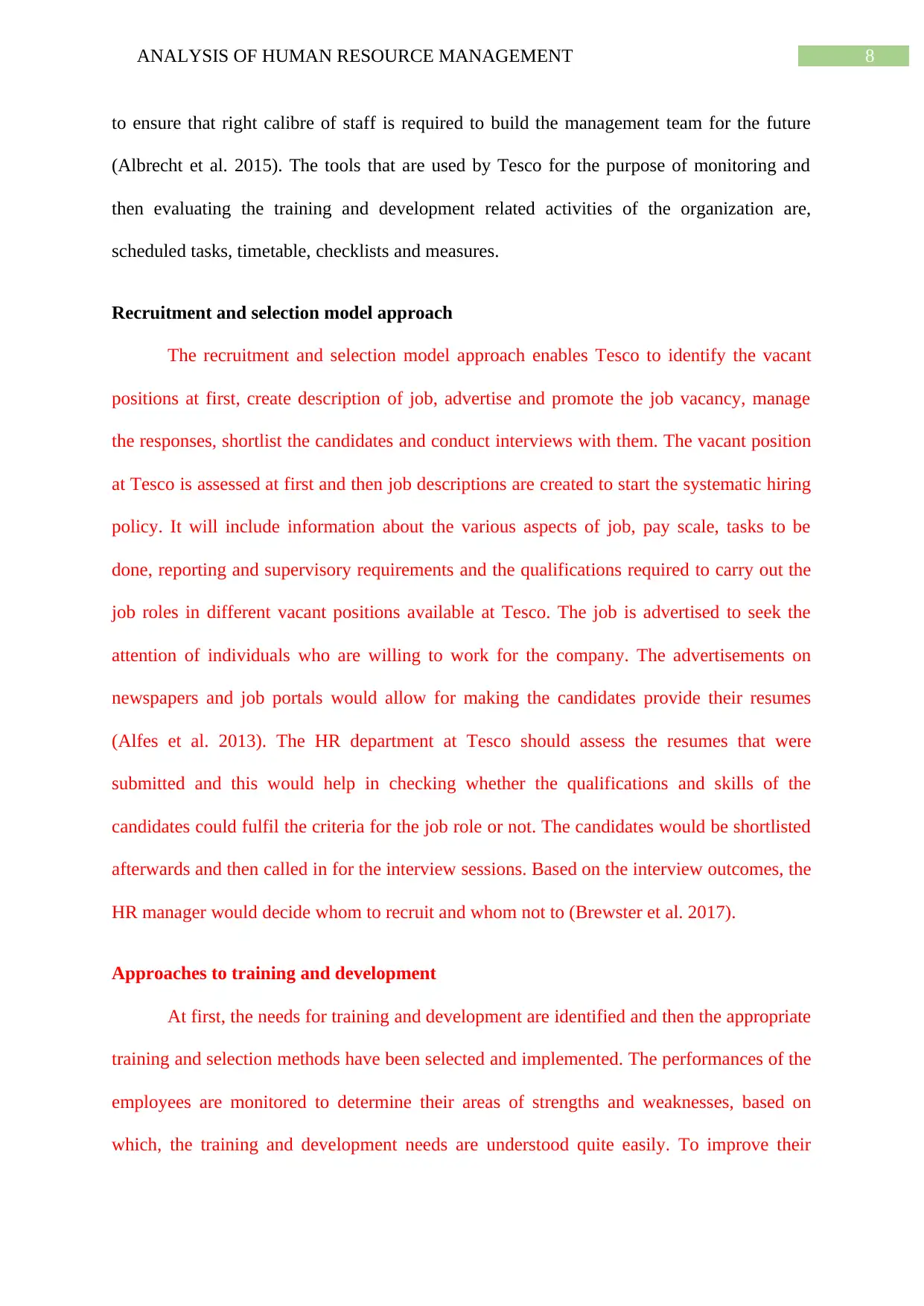
8ANALYSIS OF HUMAN RESOURCE MANAGEMENT
to ensure that right calibre of staff is required to build the management team for the future
(Albrecht et al. 2015). The tools that are used by Tesco for the purpose of monitoring and
then evaluating the training and development related activities of the organization are,
scheduled tasks, timetable, checklists and measures.
Recruitment and selection model approach
The recruitment and selection model approach enables Tesco to identify the vacant
positions at first, create description of job, advertise and promote the job vacancy, manage
the responses, shortlist the candidates and conduct interviews with them. The vacant position
at Tesco is assessed at first and then job descriptions are created to start the systematic hiring
policy. It will include information about the various aspects of job, pay scale, tasks to be
done, reporting and supervisory requirements and the qualifications required to carry out the
job roles in different vacant positions available at Tesco. The job is advertised to seek the
attention of individuals who are willing to work for the company. The advertisements on
newspapers and job portals would allow for making the candidates provide their resumes
(Alfes et al. 2013). The HR department at Tesco should assess the resumes that were
submitted and this would help in checking whether the qualifications and skills of the
candidates could fulfil the criteria for the job role or not. The candidates would be shortlisted
afterwards and then called in for the interview sessions. Based on the interview outcomes, the
HR manager would decide whom to recruit and whom not to (Brewster et al. 2017).
Approaches to training and development
At first, the needs for training and development are identified and then the appropriate
training and selection methods have been selected and implemented. The performances of the
employees are monitored to determine their areas of strengths and weaknesses, based on
which, the training and development needs are understood quite easily. To improve their
to ensure that right calibre of staff is required to build the management team for the future
(Albrecht et al. 2015). The tools that are used by Tesco for the purpose of monitoring and
then evaluating the training and development related activities of the organization are,
scheduled tasks, timetable, checklists and measures.
Recruitment and selection model approach
The recruitment and selection model approach enables Tesco to identify the vacant
positions at first, create description of job, advertise and promote the job vacancy, manage
the responses, shortlist the candidates and conduct interviews with them. The vacant position
at Tesco is assessed at first and then job descriptions are created to start the systematic hiring
policy. It will include information about the various aspects of job, pay scale, tasks to be
done, reporting and supervisory requirements and the qualifications required to carry out the
job roles in different vacant positions available at Tesco. The job is advertised to seek the
attention of individuals who are willing to work for the company. The advertisements on
newspapers and job portals would allow for making the candidates provide their resumes
(Alfes et al. 2013). The HR department at Tesco should assess the resumes that were
submitted and this would help in checking whether the qualifications and skills of the
candidates could fulfil the criteria for the job role or not. The candidates would be shortlisted
afterwards and then called in for the interview sessions. Based on the interview outcomes, the
HR manager would decide whom to recruit and whom not to (Brewster et al. 2017).
Approaches to training and development
At first, the needs for training and development are identified and then the appropriate
training and selection methods have been selected and implemented. The performances of the
employees are monitored to determine their areas of strengths and weaknesses, based on
which, the training and development needs are understood quite easily. To improve their
⊘ This is a preview!⊘
Do you want full access?
Subscribe today to unlock all pages.

Trusted by 1+ million students worldwide
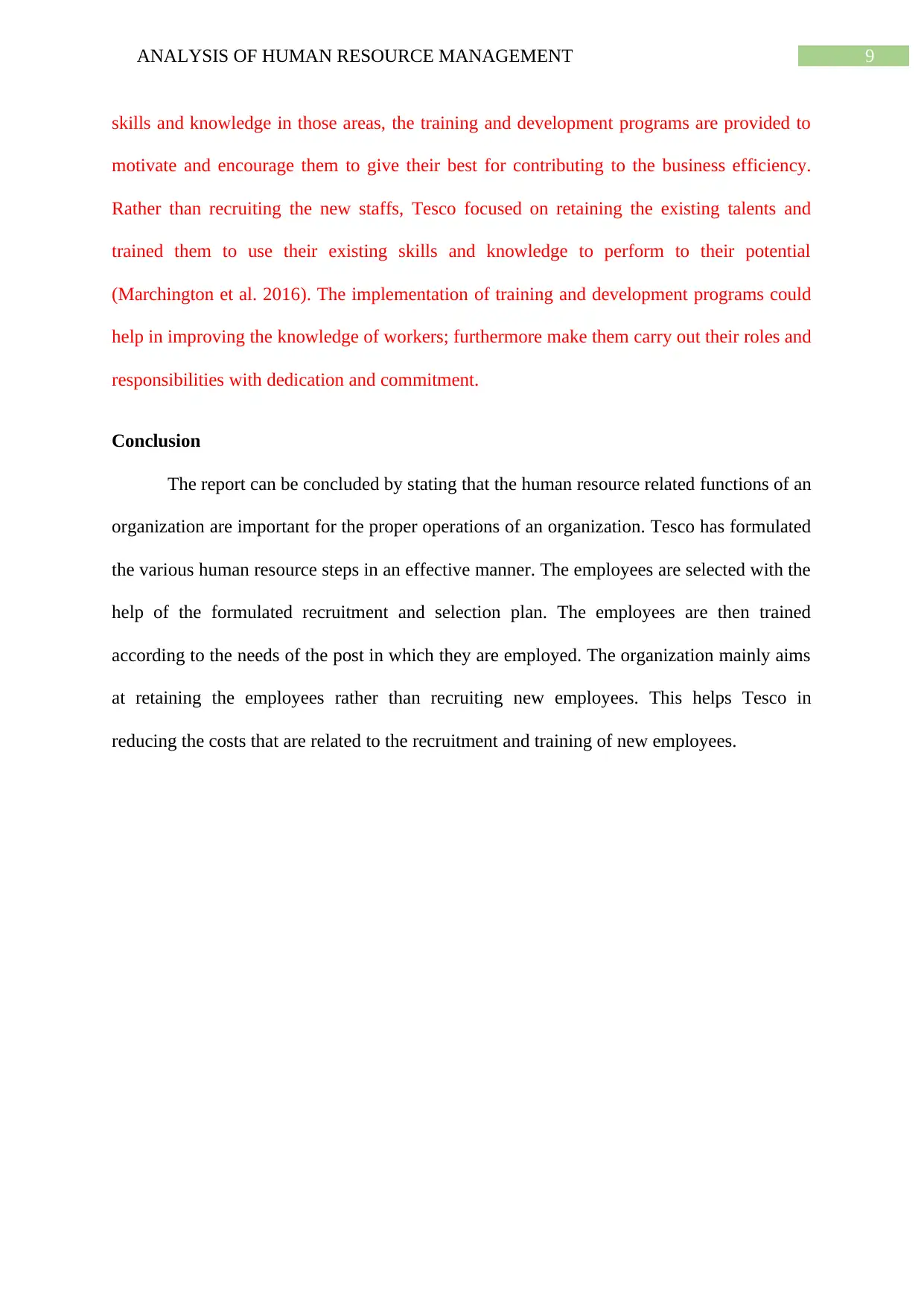
9ANALYSIS OF HUMAN RESOURCE MANAGEMENT
skills and knowledge in those areas, the training and development programs are provided to
motivate and encourage them to give their best for contributing to the business efficiency.
Rather than recruiting the new staffs, Tesco focused on retaining the existing talents and
trained them to use their existing skills and knowledge to perform to their potential
(Marchington et al. 2016). The implementation of training and development programs could
help in improving the knowledge of workers; furthermore make them carry out their roles and
responsibilities with dedication and commitment.
Conclusion
The report can be concluded by stating that the human resource related functions of an
organization are important for the proper operations of an organization. Tesco has formulated
the various human resource steps in an effective manner. The employees are selected with the
help of the formulated recruitment and selection plan. The employees are then trained
according to the needs of the post in which they are employed. The organization mainly aims
at retaining the employees rather than recruiting new employees. This helps Tesco in
reducing the costs that are related to the recruitment and training of new employees.
skills and knowledge in those areas, the training and development programs are provided to
motivate and encourage them to give their best for contributing to the business efficiency.
Rather than recruiting the new staffs, Tesco focused on retaining the existing talents and
trained them to use their existing skills and knowledge to perform to their potential
(Marchington et al. 2016). The implementation of training and development programs could
help in improving the knowledge of workers; furthermore make them carry out their roles and
responsibilities with dedication and commitment.
Conclusion
The report can be concluded by stating that the human resource related functions of an
organization are important for the proper operations of an organization. Tesco has formulated
the various human resource steps in an effective manner. The employees are selected with the
help of the formulated recruitment and selection plan. The employees are then trained
according to the needs of the post in which they are employed. The organization mainly aims
at retaining the employees rather than recruiting new employees. This helps Tesco in
reducing the costs that are related to the recruitment and training of new employees.
Paraphrase This Document
Need a fresh take? Get an instant paraphrase of this document with our AI Paraphraser
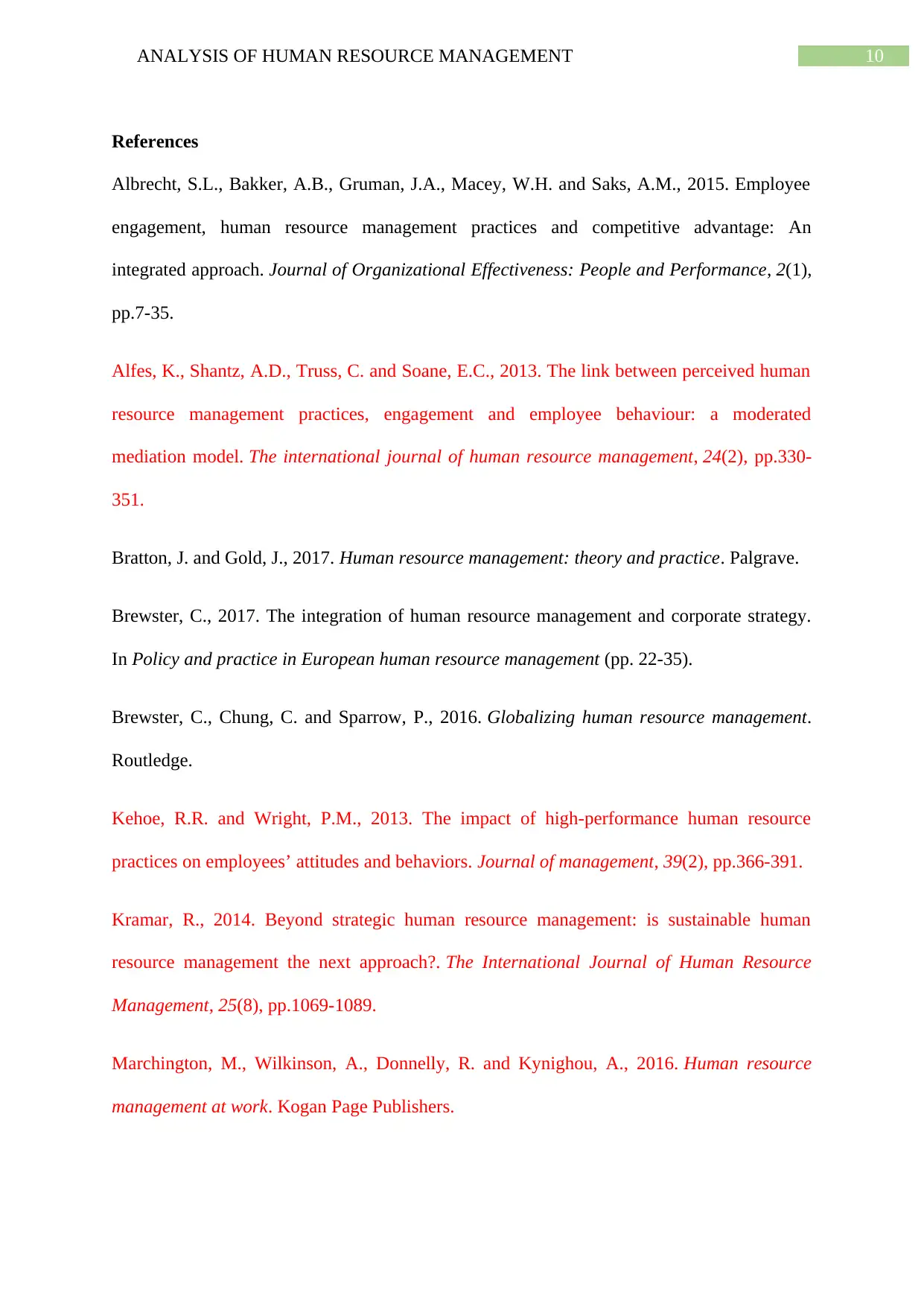
10ANALYSIS OF HUMAN RESOURCE MANAGEMENT
References
Albrecht, S.L., Bakker, A.B., Gruman, J.A., Macey, W.H. and Saks, A.M., 2015. Employee
engagement, human resource management practices and competitive advantage: An
integrated approach. Journal of Organizational Effectiveness: People and Performance, 2(1),
pp.7-35.
Alfes, K., Shantz, A.D., Truss, C. and Soane, E.C., 2013. The link between perceived human
resource management practices, engagement and employee behaviour: a moderated
mediation model. The international journal of human resource management, 24(2), pp.330-
351.
Bratton, J. and Gold, J., 2017. Human resource management: theory and practice. Palgrave.
Brewster, C., 2017. The integration of human resource management and corporate strategy.
In Policy and practice in European human resource management (pp. 22-35).
Brewster, C., Chung, C. and Sparrow, P., 2016. Globalizing human resource management.
Routledge.
Kehoe, R.R. and Wright, P.M., 2013. The impact of high-performance human resource
practices on employees’ attitudes and behaviors. Journal of management, 39(2), pp.366-391.
Kramar, R., 2014. Beyond strategic human resource management: is sustainable human
resource management the next approach?. The International Journal of Human Resource
Management, 25(8), pp.1069-1089.
Marchington, M., Wilkinson, A., Donnelly, R. and Kynighou, A., 2016. Human resource
management at work. Kogan Page Publishers.
References
Albrecht, S.L., Bakker, A.B., Gruman, J.A., Macey, W.H. and Saks, A.M., 2015. Employee
engagement, human resource management practices and competitive advantage: An
integrated approach. Journal of Organizational Effectiveness: People and Performance, 2(1),
pp.7-35.
Alfes, K., Shantz, A.D., Truss, C. and Soane, E.C., 2013. The link between perceived human
resource management practices, engagement and employee behaviour: a moderated
mediation model. The international journal of human resource management, 24(2), pp.330-
351.
Bratton, J. and Gold, J., 2017. Human resource management: theory and practice. Palgrave.
Brewster, C., 2017. The integration of human resource management and corporate strategy.
In Policy and practice in European human resource management (pp. 22-35).
Brewster, C., Chung, C. and Sparrow, P., 2016. Globalizing human resource management.
Routledge.
Kehoe, R.R. and Wright, P.M., 2013. The impact of high-performance human resource
practices on employees’ attitudes and behaviors. Journal of management, 39(2), pp.366-391.
Kramar, R., 2014. Beyond strategic human resource management: is sustainable human
resource management the next approach?. The International Journal of Human Resource
Management, 25(8), pp.1069-1089.
Marchington, M., Wilkinson, A., Donnelly, R. and Kynighou, A., 2016. Human resource
management at work. Kogan Page Publishers.
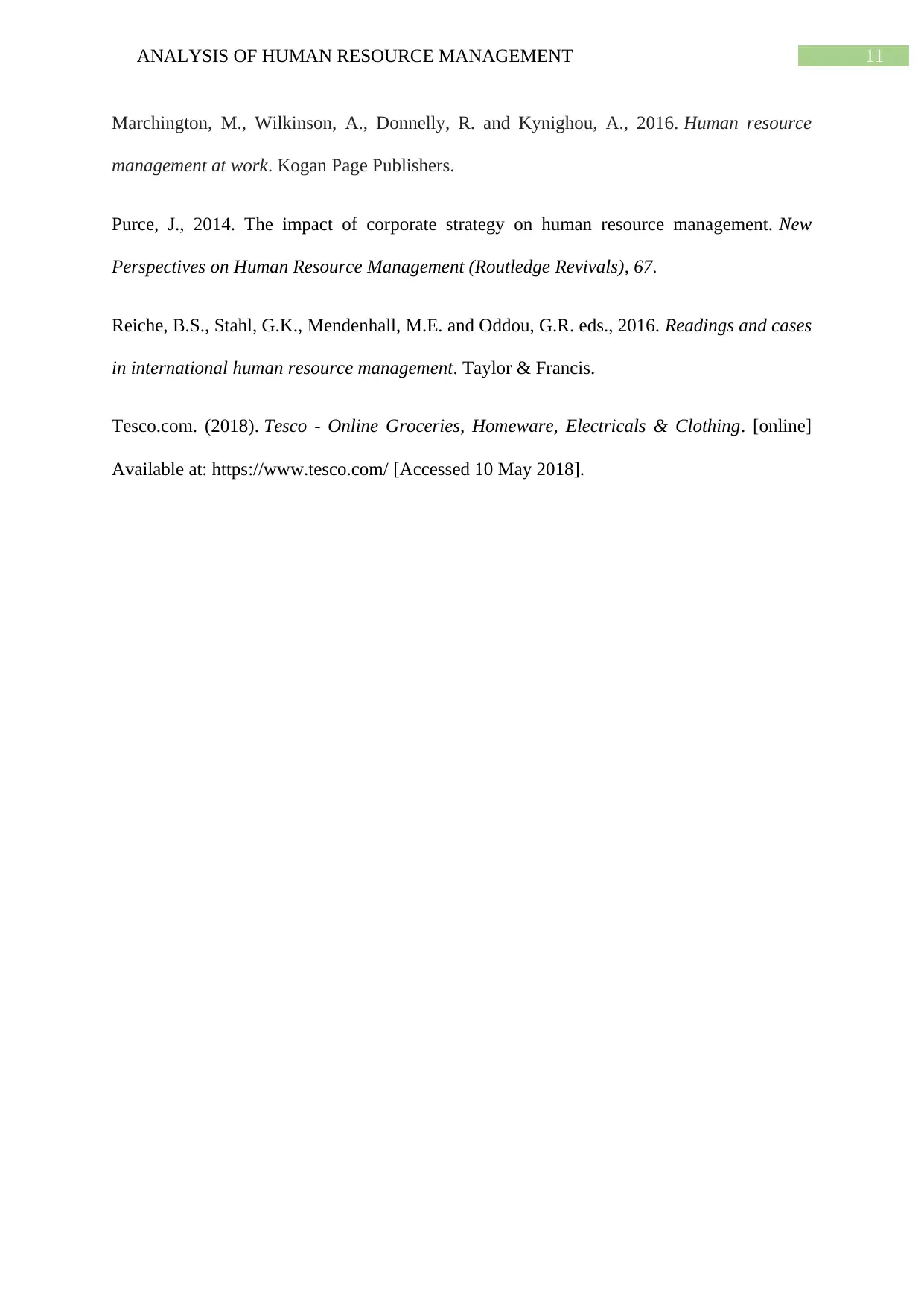
11ANALYSIS OF HUMAN RESOURCE MANAGEMENT
Marchington, M., Wilkinson, A., Donnelly, R. and Kynighou, A., 2016. Human resource
management at work. Kogan Page Publishers.
Purce, J., 2014. The impact of corporate strategy on human resource management. New
Perspectives on Human Resource Management (Routledge Revivals), 67.
Reiche, B.S., Stahl, G.K., Mendenhall, M.E. and Oddou, G.R. eds., 2016. Readings and cases
in international human resource management. Taylor & Francis.
Tesco.com. (2018). Tesco - Online Groceries, Homeware, Electricals & Clothing. [online]
Available at: https://www.tesco.com/ [Accessed 10 May 2018].
Marchington, M., Wilkinson, A., Donnelly, R. and Kynighou, A., 2016. Human resource
management at work. Kogan Page Publishers.
Purce, J., 2014. The impact of corporate strategy on human resource management. New
Perspectives on Human Resource Management (Routledge Revivals), 67.
Reiche, B.S., Stahl, G.K., Mendenhall, M.E. and Oddou, G.R. eds., 2016. Readings and cases
in international human resource management. Taylor & Francis.
Tesco.com. (2018). Tesco - Online Groceries, Homeware, Electricals & Clothing. [online]
Available at: https://www.tesco.com/ [Accessed 10 May 2018].
⊘ This is a preview!⊘
Do you want full access?
Subscribe today to unlock all pages.

Trusted by 1+ million students worldwide
1 out of 12
Related Documents
Your All-in-One AI-Powered Toolkit for Academic Success.
+13062052269
info@desklib.com
Available 24*7 on WhatsApp / Email
![[object Object]](/_next/static/media/star-bottom.7253800d.svg)
Unlock your academic potential
Copyright © 2020–2025 A2Z Services. All Rights Reserved. Developed and managed by ZUCOL.


